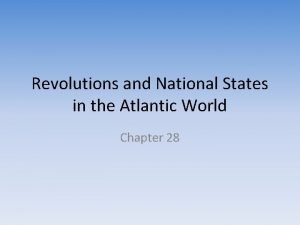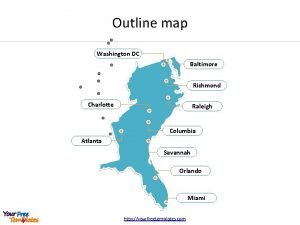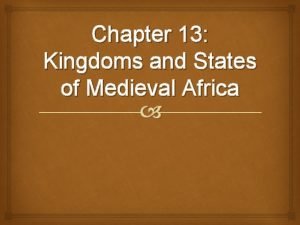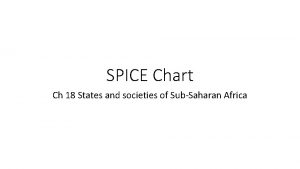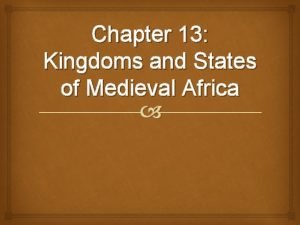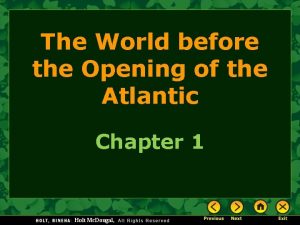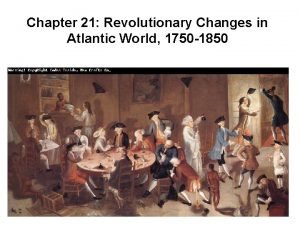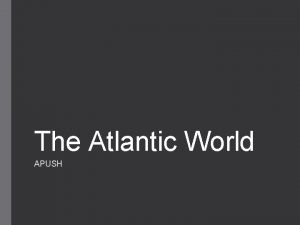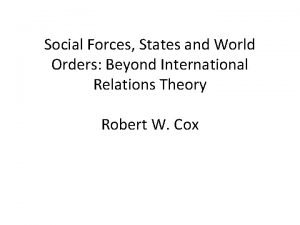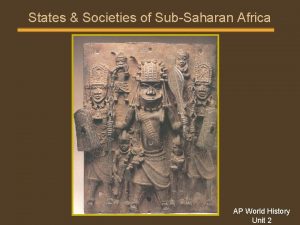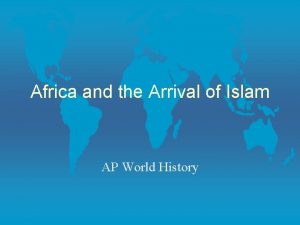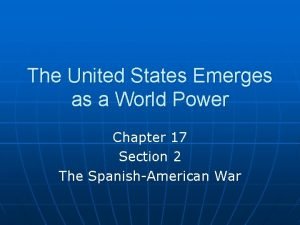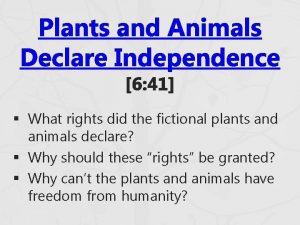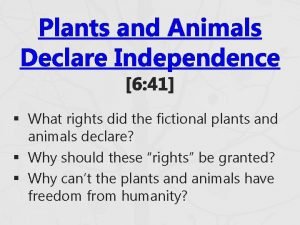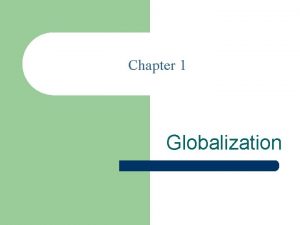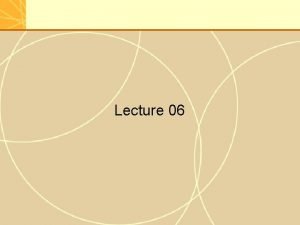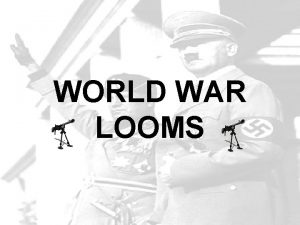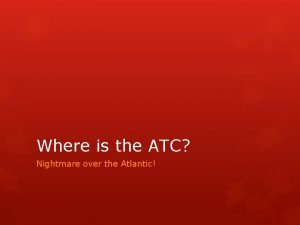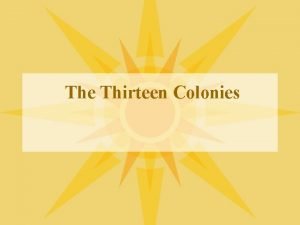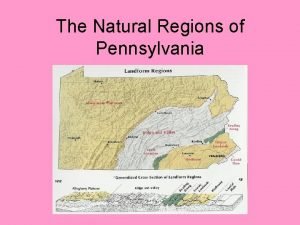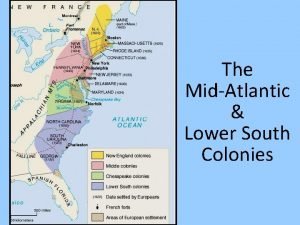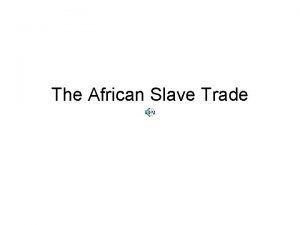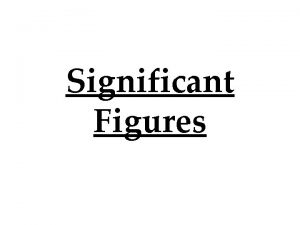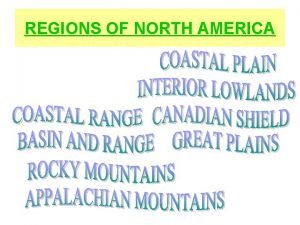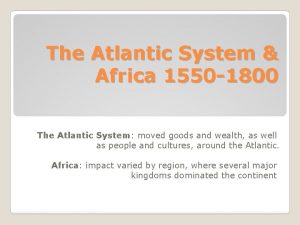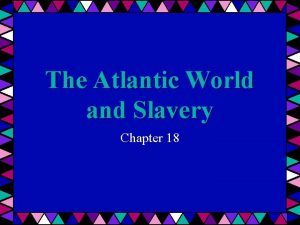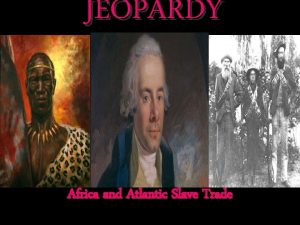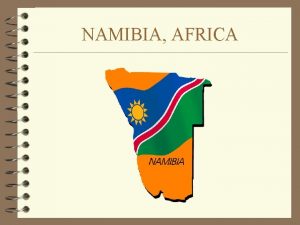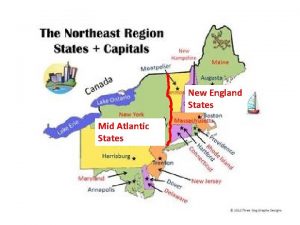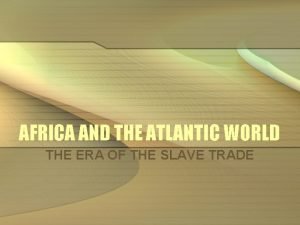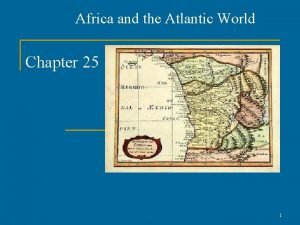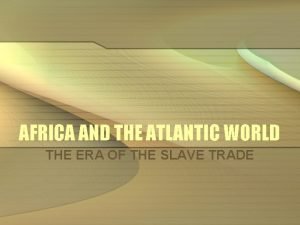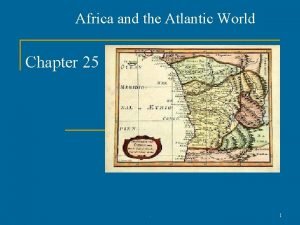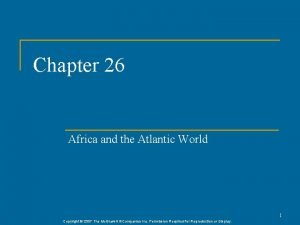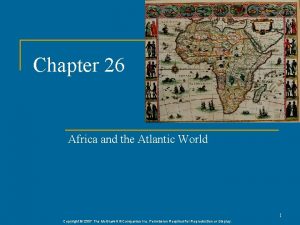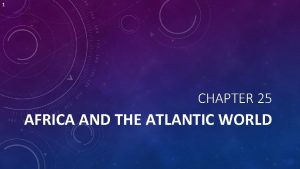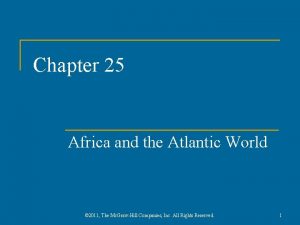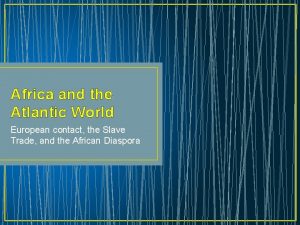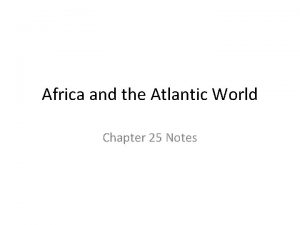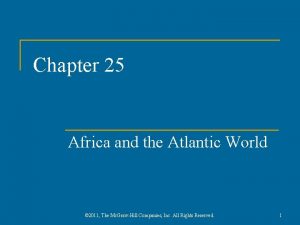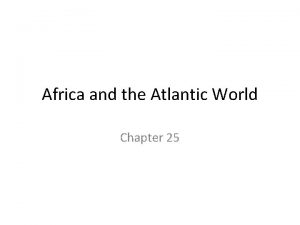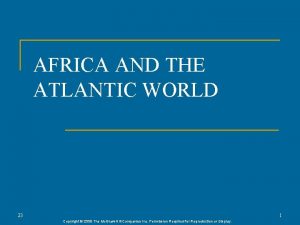Africa and the Atlantic World The States of

































- Slides: 33

Africa and the Atlantic World

The States of West Africa and East Africa ¨ Developed over 8 th-16 th centuries ¨ Kingdom of Ghana – Not related to modern State of Ghana – Major Gold Trader ¨ Mali Empire, 13 th century ¨ Songhay Empire, 15 th century – Sunni Ali (r. 1464 -1493) created effective army, navy – Musket-bearing Moroccan army destroys Songhay forces, regional city-states exert local

Africa and the Atlantic World ¨ States of West and East Africa – Islamic kingdoms flourished between the 8 th and 16 th centuries – Songhay Empire • • • Established in the 8 th century Expanded starting in 1464 by Sunni Ali Established strong central government Controlled the Niger River Established a university Began its decline in 1591 – Swahili states fell under influence starting in 1497

Africa and the Atlantic World

Africa and the Atlantic World – The Kingdom of Kongo • Contact with Europe begn in 1483 • Commercial relations established • King of Kongo converted to Christianity – Demanded everyone else to convert • Kongo gained diplomatic recognition • Europeans engaged in slave trade in Kongo – Plotted with neighboring kingdoms • War between Portuguese and Kongo in 1665 – Kongo declined and disappeared by the 1700 s

The King of Kongo and European Ambassadors

Slave Raiding in Kongo ¨ Initial Portuguese attempts at slave raiding ¨ Soon discovered it is easier to trade weapons for slaves provided by African traders – Dealt with several authorities besides Kongo ¨ Kongo kings appeal without success to slow, but not eliminate, slave trade ¨ Relations deteriorate, Portuguese attack Kongo and decapitate king in 1665 ¨ Improved slave market develops in the south

Africa and the Atlantic World – The Kingdom of Ndongo • Also known as Angola • Portuguese established colony in the coastal area in 1575 – Became a center for the slave trade • Portuguese conquest gradual over 40 years – Queen Nzinga resisted Portuguese attacks • Portuguese conquest of Angola complete after death of Nzinga – Would rule Angola until 1974

Islam in Sub-Saharan Africa ¨ Pre-Islamic paganism, ancestor worship ¨ Islam develops in commercial centers ¨ Timbuktu becomes major center of Islamic scholarship by 16 th century ¨ African traditions and beliefs blended into Islam ¨ Gender relations, standards of female modesty

Christianity in Sub-Saharan Africa ¨ Like African Islam, syncretic with African beliefs ¨ Antonian movement flourishes early 18 th century ¨ Founded by Doña Beatriz, claims possession by St. Anthony of Padua (13 th century Franciscan preacher, patron saint of Portugal) ¨ Promotes distinctly African Christianity – Jesus a black man, Kongo the holy land, heaven for Africans ¨ Christian missionaries persuade King Pedro IV of Kongo to burn her at the stake

Africa and the Atlantic World ¨ Islam and Christianity in Africa – Islam flourished in west Africa • Islam spread through Muslim merchants from Middle East • Timbuktu was an economic and cultural center • Islam blended with local traditions – Christianity flourished in Kongo and Angola • By Catholic missionaries • Antonian movement attempted to blend Christianity and African traditions – But was stamped out by Catholic missionaries

Social Change in Early Modern Africa ¨ Trade with Europeans brings new goods to Africa ¨ New crops from Americas – Manioc becomes staple bread flour ¨ Increased food supply boosts population growth despite slave trade

Africa and the Atlantic World ¨ Social Changes – European contact altered African socieities • More exposure to European goods – Textiles, metal goods – Crops from America reached Africa such as peanuts, maize • New sources of food led to population growth – – In 1500 population of Africa was 34 million In 1600 population increased to 44 million In 1700 population increased to 52 million In 1800 population increased to 60 million

Africa and the Atlantic World ¨ Population Growth in Africa

Africa and the Atlantic World ¨ Slavery not new in Africa – As a result of war or debt – Slaves were a source of labor – Slaves could be adopted into a clan ¨ Islamic slave trade – Merchants from the Middle East purchased African slaves – Markets developed in Swahili city-states in East Africa

Africa and the Atlantic World ¨ Europeans entered the slave trade in 1400 s – Began with the Portuguese capturing 12 men – By 1460, Spain and Portugal purchased 500 slaves per year • Served as miners, porters, or servants – Slave trade to the Americas began in the 1530 s • From Kongo and Angola to Brazil – Spain began using slaves to work plantations in the Caribbean in 1518 • Introduced to Mexico in 1520 s – Slavery introduced to English colonies in 1619 at Jamestown

Africa and the Atlantic World ¨ Triangular Trade emerged – European manufactured goods from Europe exchanged for slaves – African slaves delivered to Americas – Slaves sol to plantation owners ¨ Slaves embarked on “Middle Passage” – Crowded into ships – Lived in filthy and unsanitary conditions – Many slaves died on the Middle Passage • Up to 25%

Arab Slave Trader

Africa and the Atlantic World

The Middle Passage (Africa. Americas) ¨ African slaves captured by raiding parties, force-marched to holding pens at coast ¨ Middle passage under horrific conditions – 4 -6 weeks – Mortality initially high, often over 50%, eventually declined to 5% ¨ Total slave traffic, 15 th-18 th c. : 12 million ¨ Approximately 4 million killed before arrival

Slaves at Work in a Mine

Impact on African Regions ¨ Rwanda, Bugunda, Masai, Turkana resist slave trade ¨ Benefit from distance from slave ports on western coast ¨ Other societies benefit from slave trade profit – Asante, Dahomey, Oyo peoples

Social Effects of Slave trade ¨ Total African population expands due to importation of American crops ¨ Yet millions of captured Africans removed from society, deplete regional populations ¨ Distorted sex ratios result – 2/3 of slaves male, 14 -35 years of age – Encouraged polygamy, women acting in traditionally male roles

Political Effects of Slave Trade ¨ Introduction of firearms increases violence of pre-existing conflicts ¨ More weapons, more slaves; more slaves, more weapons ¨ Dahomey people create army dedicated to slave trade

Africa and the Atlantic World ¨ Effects of Slave Trade – Some African societies benefited from the slave trade, particularly west Africa – 16 million lost to the Atlantic slave trade in addition to Islamic slave trade – Population imbalance resulted from slave trade • 2/3 of exported slaves were males 14 to 35 years old • Polygamy became common in Angola – Warfare broke out just to engage in the slave trade

Africa and the Atlantic World African Slave Export

Africa and the Atlantic World ¨ African Diaspora – Africans dispersed throughout the entire Western Hemisphere • • • About 50% went to Caribbean About 33 % went to Brazil About 12 % went to Central America About 5 % went to North America Left an indelible mark on society – Plantation Societies • Consisted of labor intensive crops such as sugar, cotton, tobacco • Highly stratified societies

Africa and the Atlantic World Destinations of African Slaves

Africa and the Atlantic World – Slave resistance had different forms • Passive resistance – slaves worked inefficiently for their masters on purpose • Escape – Into mountains, swamps forests and form communities • Revolt – Feared most by slave owners outnumbered by their slaves – Few attempts at revolt were crushed by slave owners – French colony of Santo Domingo abolished slavery as a result of a revolt in 1793, renamed Haiti

Africa and the Atlantic World ¨ Slaves created new culture to adapt to their environment – Preserved elements of African cultures – Created new language mixing African and European languages – Religion became mixture of African traditions and Christianity – Diet mixed with African and European cuisines

Africa and the Atlantic World ¨ End of the Slave Trade and Abolition of Slavery – Opposition to the abolition of Atlantic slave trade from the beginning • On moral and religious grounds – American and French Revolutions called for liberty and equality – Accounts of Olaudah Equiano (1745 -1797) stung consciences of British public • Launched abolitionist movement in Britain – Economic realities led to end of slave trade and slavery • Declining prices for sugar • Rising costs for upkeep o slaves • Industrial Revolution and investment in new technology more profitable than slavery

Africa and the Atlantic World ¨ Slave Trade Abolished throughout Europe – Denmark in 1803 – Britain in 1807 – United States in 1808 – France in 1814 – Netherlands in 1817 – Spain in 1845

Africa and the Atlantic World ¨ Slavery later abolished – 1833 in British colonies – 1848 in French colonies – 1865 in the United States – 1886 in Cuba – 1888 in Brazil – 1960 s in Saudi Arabia and Angola ¨ “Unofficial” slavery still exists
 Ap world history chapter 25 africa and the atlantic world
Ap world history chapter 25 africa and the atlantic world Revolutions and national states in the atlantic world
Revolutions and national states in the atlantic world South atlantic states
South atlantic states Chapter 13 kingdoms and states of medieval africa
Chapter 13 kingdoms and states of medieval africa Medieval africa geography
Medieval africa geography Great zimbabwe spice chart
Great zimbabwe spice chart Chapter 13 kingdoms and states of medieval africa
Chapter 13 kingdoms and states of medieval africa The world before the opening of the atlantic
The world before the opening of the atlantic Chapter 21 revolutionary changes in the atlantic world
Chapter 21 revolutionary changes in the atlantic world Bacon's rebellion apush
Bacon's rebellion apush There were 11
There were 11 Map of northern united states
Map of northern united states Tyranny
Tyranny Social forces states and world orders
Social forces states and world orders Ap art history
Ap art history Sudanic states ap world history
Sudanic states ap world history The united states emerges as a world power
The united states emerges as a world power Savage safe handling auburn maine
Savage safe handling auburn maine Study jams symbiosis
Study jams symbiosis Atlantic puffin and rabbit symbiotic relationship
Atlantic puffin and rabbit symbiotic relationship New england mid atlantic and southern colonies
New england mid atlantic and southern colonies Chapter 17 atlantic revolutions and their echoes
Chapter 17 atlantic revolutions and their echoes The changing world output and world trade picture
The changing world output and world trade picture The changing world output and world trade picture
The changing world output and world trade picture Atlantic charter summary
Atlantic charter summary Nightmare over the atlantic
Nightmare over the atlantic The mid atlantic colonies
The mid atlantic colonies Atlantic coastal plain pa
Atlantic coastal plain pa Midatlantic colonies
Midatlantic colonies Atlantic slave trade
Atlantic slave trade The atlantic ocean gets about 3-5 ______ wider each year.
The atlantic ocean gets about 3-5 ______ wider each year. All nonzero digits are significant.
All nonzero digits are significant. Romero britto colorful underwear
Romero britto colorful underwear Plain south america
Plain south america

